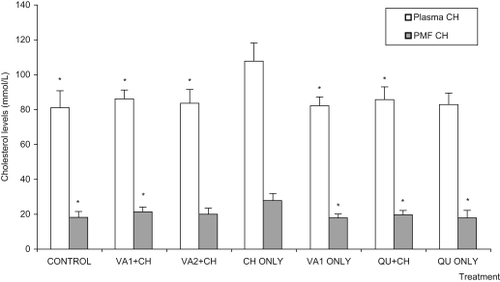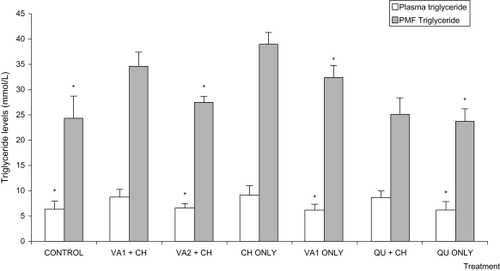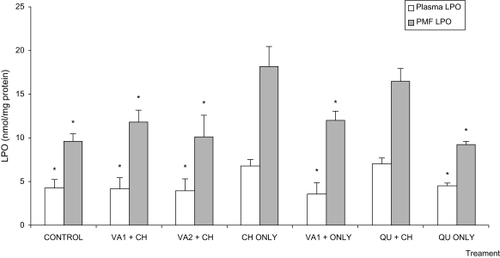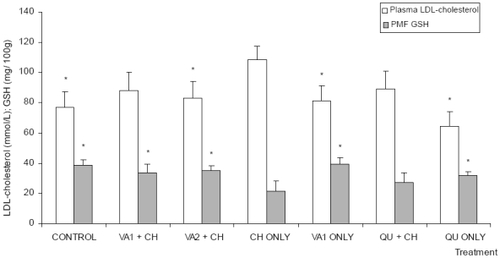Abstract
We investigated the lipid-lowering effects of methanolic extract of Vernonia amygdalina (VA) leaves in rats fed an high cholesterol diet, and compared with a standard hypolipidemic drug, Questran (Qu). The effects of VA on the lipid profile were assessed by measuring the levels of total cholesterol, triglyceride, low-density lipoprotein (LDL) cholesterol, high-density lipoprotein (HDL) cholesterol, lipid peroxidation (LPO), phospholipid, and glutathione (GSH) in the plasma and liver of the rats. Administration of cholesterol at a dose of 30 mg/0.3 ml, five times in a week for nine consecutive weeks resulted in a significant increase (p < 0.05) in plasma and post mitochondrial fraction (PMF) cholesterol levels by 33% and 55%, respectively. However, treatment with extract of VA at doses of 100 and 200 mg/kg caused a dose dependent reduction in the plasma and PMF cholesterol by 20%, 23% and 23%, 29%, respectively. Similar reduction in cholesterol levels was obtained in Qu-treated rats. Furthermore, VA at 200 mg/kg decreased the plasma and PMF LDL-cholesterol levels by 23% and 49%, and also decreased plasma and PMF triglyceride levels by 29% and 28%, respectively. Also, VA at 100 and 200 mg/kg caused a dose-dependent increase in plasma HDL-cholesterol levels by 41% and 59%, respectively. However, there were no significant differences (p > 0.05) in the PMF HDL-cholesterol and phospholipid levels of the treated rats when compared to hypercholesterolemic rats. There were significant decreases (p < 0.05) in the LPO levels of extract-treated rats. Precisely, VA at 100 and 200 mg/kg decreased the levels of plasma and PMF LPO by 38%, 42% and 35%, 45%, respectively. In addition, VA augmented the cholesterol-induced decrease in PMF glutathione levels of the rats. Taken together, these results suggest the lipid-lowering effects of VA and, probably serve as a new potential natural product for the treatment of hyperlipidemia.
Introduction
It is known that hypercholesterolemia is a risk factor for cardiovascular diseases (CVD) such as atherosclerosis and myocardial infarction, which is a common cause of mortality and morbidity (CitationWald and Law 1995; CitationKrieger 1998). Although several factors, such as life style, a diet rich in cholesterol, age and hypertension, have been reported to cause heart failure (CitationSchaefer et al 1995), high levels of cholesterol, particularly LDL cholesterol, are mainly responsible for hypercholesterolemia (CitationKrieger 1998). Recently, hypercholesterolemia has been associated with enhanced oxidative stress related to increase lipid peroxidation (CitationAdaramoye et al 2005). Increased generation of oxidized LDL is a major factor in the vascular damage associated with high cholesterol levels (CitationPritchard et al 1995). Hence, the inhibition of oxidative stress under hypercholesterolemic conditions is considered to be an important therapeutic approach and efforts have been made to identify the antioxidative functions of various medicinal plants (CitationHu et al 2006; CitationTomotake et al 2006; CitationVisavadiya and Narasimhacharya 2007).
Drugs that lower cholesterol such as fibrates and bile acid sequestrants were used for several decades, but the high prevalence of their adverse effects led to the introduction of statins (HMG CoA inhibitors) (CitationMiller 2001). Although the adverse effect of statins is relatively low, one rare effect called rhabdomyolysis can be very serious (CitationMiller 2001). This effect is very pronounced when a statin is taken with another type of cholesterol lowering drug, in particular fibrates (CitationMiller 2001). Rhabdomyolysis led to the voluntary withdrawal of cerivastatin (Baycol) by its manufacturer. In view of the adverse effects associated with synthetic lipid-lowering drugs, the quest for natural products with lipid-lowering potential and with minimal or no side effect is warranted.
Plants have been the companions of man since time immemorial and formed the basis of useful drugs since they are less toxic than synthetic drugs. Screening of medicinal plants presents an avenue for the discovery of new drugs. Vernonia amygdalina (VA) is a shrub that grows predominantly in the tropical Africa. Leaves from this plant serve as food vegetable and culinary herb in soup (CitationArgheore et al 1998). In Nigerian herbal homes, extracts of the plant are used as tonic, in the control of tick and treatment of cough, feverish condition, constipation and hypertension (CitationRegassa 2000; CitationKambizi and Afolayan 2001; CitationAmira and Okubadejo 2007). Phytochemical screening of VA revealed the presence of saponins, sesquiterpene, and flavonoids (CitationIgile et al 1994). Strong antioxidant activities have been reported for flavonoids from VA and, its saponins have been reported to elicit antitumoral activities in leukemia cells (CitationJisaka et al 1993). Peptides from VA are known to be potent inhibitor of mitogen-activated proteins kinases, which are crucial for breast tumor growth and also represents a key regulatory point for the tumour (CitationIzevbigie 2003; CitationIzevbigie and Ernest 2005). However, there is dearth of scientific data to support the folkloric use of this plant in the treatment of hypertension or related vascular diseases in Nigerian herbal homes. Therefore, the present work was designed to provide scientific proof of the use of VA in the treatment of vascular diseases.
Methods
Chemicals
Cholesterol and thiobarbituric acid (TBA) were procured from Aldrich Chemical Co. (Milwaukee, WI, USA). Questran (Bristol-Myers Squibb, Hounslow, UK) was purchased from a local chemist in Ibadan, Nigeria. Diagnostic kits for cholesterol and triglyceride were procured from Boehringer Mannheim GmbH Diagnostica, Germany. Other reagents were of analytical grade and the purest quality available.
Preparation of plant extract
Fresh leaves of Vernonia amygdalina were obtained from a local market, Sasa in Ibadan, Nigeria. The botanical identification and authentication was confirmed at the Department of Botany, University of Ibadan, Nigeria, where voucher specimen was kept at the herbarium (Voucher no. UI-02567). The leaves were air-dried at room temperature and then powdered. The powdered sample (1 kg) was defatted with n-hexane (2.5 litres) and then extracted with 75% methanol (2.5 litres) overnight in a soxhlet extractor (Sri Rudran Instrument Co, Chennai, India). The methanolic extract was concentrated and evaporated to dryness at 50 °C with a rotary evaporator under reduced pressure, and the yield of the preparation was 6.8%. The extract was dissolved in water at a concentration of 4 g/100 ml, and aliquots of different concentrations were given orally to the animals with a gavage needle.
Grouping of animals and study design
Forty-two male albino rats (Wistar strain) weighing between 120–130 g were used as experimental animals. The rats were kept in cages in a room maintained at 26–29 °C with a 12-hour light-dark cycle for 4-weeks to acclimatize, and were allowed free access to food and water ad libitum. The protocol conforms to the guidelines of the National Institute of Health (NIH) (NIH publication 85–23, 1985) for laboratory animal care and use. Animals were randomly distributed into seven groups of six animals each. Group A served as control (received drug-vehicle, water), rats in groups B and C were administered VA at doses 100 and 200 mg/kg body weight, respectively in addition to oral administration of cholesterol. Rats in group D were intubated with cholesterol-only (hypercholesterolemic animals). Rats in group E served as positive control and were given VA at a dose of 100 mg/kg body weight, while rats in group F were intubated with cholesterol and Questran. Rats in group G were treated orally with Questran-only. Cholesterol was orally administered at a dose of 30 mg/0.3 ml/ animal, while Questran was given at a therapeutic dose of 0.26 g/kg body weight (CitationAdaramoye et al 2005). Extract of VA was administered at doses 100 and 200 mg/kg body weight (CitationIwalokun et al 2006). VA, Questran, and cholesterol were administered five times in a week for a period of nine weeks.
Sample collection
After the last dose of drugs, rats were fasted overnight and sacrificed by cervical dislocation. Blood was collected from the heart into EDTA tubes. Plasma was prepared by centrifugation at 3,000 g for 15 minutes in an MSC bench centrifuge (Beckman and Hirsch, Burlington, IO, USA). The plasma was used in the estimation of lipid profile. Liver from the animals were rinsed in ice- cold 1.15% KCl, dried and weighed. It was homogenized in 4 volumes of ice-cold 5 mM phosphate buffer, pH 7.4, and centrifuged at 10,000 g for 20 min to obtain post mitochondrial fraction (PMF). Organs such as kidneys, lungs, liver and heart were removed from the animals and weighed.
Determination of triglyceride and cholesterol levels
Triglyceride and cholesterol levels were assayed using Boehringer Mannheim diagnostic kits.
Determination of protein and phospholipid levels
Protein level was determined by the method of CitationLowry and colleagues (1951). Briefly, the method involved the reduction of phospho-18 molybdic tungstic complex by phenolic groups present in amino acids to blue precipitate at alkaline pH. The precipitate was read spectrophotometrically at 720 nm. The level of phospholipid was assayed by the method of CitationFiske and SubbaRow (1925). The method involves the release of inorganic phosphate from phospholipid in presence of an acceptor in aqueous medium. The inorganic phosphate reacts with ammonium molybdate and ascorbate to form a blue precipitate which was read at 660 nm spectrophotometrically.
Determination of HDL and LDL cholesterol levels
The lipoproteins, VLDL and LDL were precipitated using phosphotungstic acid and magnesium chloride. After centrifugation, the supernatant contained the HDL fraction, which was assayed for cholesterol with diagnostic kit. LDL cholesterol was calculated using the formula of CitationFriedewald and colleagues (1972).
Determination of lipid peroxidation (LPO) and reduced glutathione (GSH) levels
Lipid peroxidation and reduced glutathione levels were assayed by the methods of CitationWalls and colleagues (1976) and CitationMoron and colleagues (1979), respectively. Briefly, GSH level was assayed by measuring the rate of formation of chromphoric product in a reaction between DTNB (5, 51-dinitro bis (2-nitrobenzoic acid) and free sulphydryl groups (such as GSH) at 412 nm, while the extent of LPO was estimated by the measuring the intensity of pink precipitate formed in a reaction between malondialdehyde (MDA, end-product of lipid peroxidation) and thiobarbituric acid at 535 nm spectrophotometrically.
Statistical analysis
Results were expressed as the mean ± S.D. (n = 6). A one-way analysis of variance (ANOVA) was used for the data analysis, using SPSS (Statistical Package for Social Sciences) (10.0) software. Significant differences between groups were detected in the ANOVA using Duncan’s Multiple Range Test at p values less than 0.05 and 0.001.
Results
depicts the effect of Vernonia amygdalina on body weight, organs weight and relative weight of visceral organs of hypercholesterolemic rats. Extract of VA at 100 and 200 mg/kg did not affect the body weight gain during this study. However, there was a significant increase (p < 0.001) in the body weight gain of hypercholesterolemic rats when compared with the control. In , there were significant (p < 0.001) increases in the plasma HDL cholesterol levels of animals treated with VA when compared with the hypercholesterolemic rats. Furthermore, administration of cholesterol caused a significant increase (p < 0.05) in the plasma and PMF total cholesterol and triglyceride levels of the rats ( and ). Precisely, plasma and PMF levels of total cholesterol and triglyceride were increased by 33%, 55% and 44%, 80%, respectively. The hypercholesterolemia induced by the dietary cholesterol was significantly attenuated (p < 0.05) in animals treated with VA and Questran. Furthermore, VA at a dose of 200 mg/kg was able to decrease the hypertriglyceridemia induced by dietary cholesterol (). Administration of dietary cholesterol significantly (p < 0.05) increased plasma and PMF LPO by 58% and 90%, respectively (). However, the cholesterol-induced increase in plasma and PMF LPO was significantly (p < 0.05) attenuated by extract of VA. Specifically, VA at 100 and 200 mg/kg decreased the plasma and PMF LPO by 38%, 42% and 35%, 45%, respectively. and show that cholesterol administration significantly (p < 0.05) elevated the plasma and PMF LDL cholesterol levels of hypercholesterolemic rats. Specifically, plasma and PMF LDL cholesterol levels were elevated by 41% and 115%, respectively. However, VA at 200 mg/kg significantly attenuated (p < 0.05) the cholesterol-induced increase in plasma and PMF LDL cholesterol by 23% and 49%, respectively. Similarly, the cholesterol-induced decrease in PMF reduced glutathione levels of hypercholesterolemic rats were significantly (p < 0.05) ameliorated in animals treated with VA ().
Figure 1 Effect of Vernonia amygdalina on plasma and post mitochondrial fraction (PMF) cholesterol levels of hypercholesterolemic rats.
Abbreviations: CH, Cholesterol; VA, Vernonia amygdalina; QU, Questran; PMF, Post mitochondrial fraction; VA1, 100 mg/kg; VA2, 200 mg/kg.

Figure 2 Effect of Vernonia amygdalina on plasma and post mitochondrial fraction (PMF) triglyceride levels of hypercholesterolemic rats.
Abbreviations: CH, Cholesterol; VA, Vernonia amygdalina; QU, Questran; PMF, Post mitochondrial fraction; VA1, 100 mg/kg; VA2, 200 mg/kg.

Figure 3 Effect of Vernonia amygdalina on plasma and post mitochondrial fraction (PMF) lipid peroxidation levels of hypercholesterolemic rats.
Note: *Significantly different from CH group at p < 0.05.
Abbreviations: CH, Cholesterol; VA, Vernonia amygdalina; QU, Questran; LPO, Lipid peroxidation; VA1, 100 mg/kg; VA2, 200 mg/kg.

Figure 4 Effect of Vernonia amygdalina on plasma LDL-cholesterol and post mitochondrial fraction (PMF) reduced glutathione levels of hypercholesterolemic rats.
Note: *Significantly different from CH group at p< 0.05.
Abbreviations: CH, Cholesterol; VA, Vernonia amygdalina; QU, Questran; LDL, Low-density lipoprotein; PMF, Post mitochondrial fraction; GSH, Reduced glutathione; VA1, 100 mg/kg; VA2, 200 mg/kg.

Table 1 Effect of Vernonia amygdalina on body weight, organ weight, and relative weight of visceral organs of hypercholesterolemic rats
Table 2 Effect of Vernonia amygdalina on protein, phospholipid, high-density lipoprotein (HDL), and low-density lipoprotein (LDL) cholesterol levels of hypercholesterolemic rats
Discussion
The presence of a high amount of cholesterol in the diet has been demonstrated to elevate plasma cholesterol and may increase aortic atherosclerosis (LRCP 1984). Several studies have indicated that diet treatment or drug therapy to regulate cholesterol can reduce subsequent CVD-associated mortality and morbidity (CitationKwiterovich 1997). On the basis of this, great efforts have been made to reduce the risk of CVD through the regulation of cholesterol, thus the therapeutic benefits of plant foods have been the focus of many extensive dietary studies (CitationYokozawa et al 2006; CitationZhang et al 2007).
In the present study, we investigated the lipid-lowering effects of Vernonia amygdalina in rats fed on high cholesterol diet for a period of nine weeks. Notably, the rats intubated with dietary cholesterol showed higher plasma and hepatic levels of total cholesterol and triglyceride than the extract-treated animals. It is obvious that the reducing effect produced by Vernonia amygdalina on plasma and PMF cholesterol levels is dose dependent. Dietary cholesterol has been shown to reduce fatty acid oxidation, which, in turn, increases the levels of hepatic and plasma triglycerol (CitationFungwe et al 1993). The elevated levels of plasma and PMF triglyceride obtained in cholesterol-fed rats are in line with the findings of CitationAdaramoye and colleagues (2005) and CitationYokozawa and colleagues (2006). The results suggest that VA (200 mg/kg) reduced the hepatic triglyceride biosynthesis and favour the redistribution of cholesterol among the lipoprotein molecules. This observation is consistent with the findings of CitationNwanjo (2005) in which VA significantly attenuated the hepatic triglyceride and LDL cholesterol levels of streptozotocin diabetic rats.
The crucial risk factor for CVD includes a low level of HDL-cholesterol. The association between a low level of HDL-cholesterol and an increased risk of CVD has been well established through epidemiological and clinical studies (CitationAssmann and Gotto 2004). Since low level of HDL-cholesterol plays a direct role in the atherogenic process, therapeutic intervention to raise HDL-cholesterol together with other risk factors is widely encouraged. In this study, treatment with VA led to significant elevation of plasma HDL-cholesterol, indicating its promising protective role against CVD. The protective roles of HDL cholesterol from CVD have been suggested to occur in various ways (CitationNofer et al 2002). HDL exerts part of its anti-atherogenic effect by counteracting LDL oxidation and, recent studies also showed that HDL promotes the reverse cholesterol transport pathway, by inducing an efflux of excess accumulated cellular cholesterol and prevents the generation of an oxidatively modified LDL (CitationYokozawa et al 2006). Furthermore, HDL inhibits the oxidation of LDL by transition metal ions, but also prevents 12-lipooxygenase-mediated formation of lipid hydroperoxides (CitationNofer et al 2002). On the basis of our results, VA may probably plays an anti-atherogenic role through the inhibition of lipids oxidation, (due to its anti-lipoperoxidative effect observed in this study) as well as the elevation of HDL cholesterol.
LDL cholesterol is another primary target of CVD risk-reduction therapy (CitationKwiterovich 1997). In this study, VA administered at a dose of 200 mg/kg lowered LDL cholesterol levels of hypercholesterolemic rats. Excess LDL can be deposited in the blood vessel walls and becomes a major component of atherosclerotic plaque lesions. Therefore, plasma LDL cholesterol level may be used for monitoring the treatment of patients with elevated blood cholesterol levels. In view of our results, VA elicited beneficial effects by lowering the plasma and PMF levels of cholesterol including low-density lipoprotein of the treated rats. Oxidative stress, defined as a disruption of the balance between oxidative and antioxidative processes, plays an important role in the pathogenesis of atherosclerosis (CitationYokozawa et al 2006). A cholesterol rich diet results in increased lipid peroxidation, followed by hypercholesterolemia (CitationAdaramoye et al 2005). The relationship between oxidative stress and cholesterol level was confirmed in the present study, in which the hepatic glutathione (GSH), an indicator of antioxidant defense, exhibited a negative correlation with the hepatic total cholesterol levels of hypercholesterolemic rats, but a positive correlation with the cholesterol levels of extract-pretreated rats. Therefore, VA may elicit some health benefits through the modulation of physiologic functions including the atherogenic lipid profile.
Evidence from this study confirms the lipid-lowering effects of VA in rats fed on high cholesterol diet. VA at 200 mg/kg was effective in reducing the levels of plasma and PMF total cholesterol as well as low-density lipoprotein cholesterol. Further studies are warranted to determine the exact component in VA responsible for the observed effect and, such component may be a candidate for use as a prophylactic agent against hypercholesterolemia.
References
- AdaramoyeOANwaneriVOAnyanwuKCPossible anti-atherogenic effect of kolaviron (a Garcinia kola seed extract) in hypercholesterolemic ratsClin Exp Pharmacol Physiol20053240615730433
- AmiraCAOkubadejoNUFrequency of complementary and alternative medicine utilization in hypertensive patients attending an urban tertiary care centres in NigeriaBMC Complementary and Alternative Medicine20077304817903257
- ArgheoreEMMakkarHPSBeckerKFeed value of some browse plants from central zone of Delta State of NigeriaTrop Sci19983897104
- AssmannGGottoAMJrHDL cholesterol and protective factors in atherosclerosisCirculation2004109III8III1415198960
- FiskeCHSubbaRowYThe colorimetric determination of phosphorusJ Biol Chem19256637583
- FriedewaldWTLevyRIFredricksonDSEstimation of the concentration of LDL cholesterol in plasma, without use of the preparative ultra- centrifugeClin Chem1972184995024337382
- FungweTVCagenLMCookGADietary cholesterol stimulated hepatic biosynthesis of triglyceride and reduces oxidation of fatty acids in the ratJ Lipid Res199334933418354959
- HuSHLiangZCChiaYCAntihyperlipidemic and antioxidant effects of extracts from Pleurotus citrinopileatusJ Agric Food Chem20062221031016536582
- IgileGOOleszekWJurzystaMFlavonoids from Vernonia amygdalina and their antioxidant activitiesJ Agric Food Chem19944224458
- IwalokunBAEfededeBUAlabi-SofundeJAHepatoprotective and antioxidant activities of Vernonia amygdalina on acetaminophen-induced hepatic damage in miceJ Med Food200695243017201640
- IzevbigieEBDiscovery of water-soluble anticancer agents (edotides) from a vegetable found in Benin City, NigeriaExp Biol Med20032282938
- IzevbigieEBErnestOPhytochemotherapy for cancerUS Patent6,849,6042005
- JisakaMOhigashiHTakagawaKSteroid glucosides from Vernonia amygdalina. A possible Chimpanzee medicinal plantPhytochemistry19933440913
- KambiziLAfolayanAJAn ethnobotanical study of plants used for the treatment of sexually transmitted diseases (njovhera) in Guruve District, ZimbabweJ Ethnopharmacol2001775911483371
- KriegerMThe “best” of cholesterols, the “worst” of cholesterols: a tale of two receptorsProc Natl Acad Sci USA1998954077809539689
- KwiterovichPOJrThe effect of dietary fat, antioxidants, and pro-oxidants on blood lipids, lipoproteins, and atherosclerosisJ Am Diet Assoc199797S31419216565
- LowryOHRosenbroughNJFarrALProtein measurement with Folin-phenol reagentJ Biol Chem19511932657514907713
- Lipid Research Clinics ProgramThe lipid research clinics, coronary primary prevention trial results 1. Reduction in incidence of coronary heart diseaseJ Am Med Assoc198425135164
- MillerCAUpdate on statins and other lipid-lowering drugsGeriatr Nurs2001222767711606910
- MoronMADepierreJWMannervickBLevels of glutathione, glutathione reductase and glutathions-S-transferase activities in rat lung and liverBiochem Biophys Acta19795826778760819
- NwanjoHUEfficacy of aqueous leaf extract of Vernonia amygdalina on plasma lipoprotein and oxidative status in diabetic rat modelsNiger J Physiol Sci200520394217220925
- NoferJRKehrelBFobkerMHDL and arteriosclerosis: beyond reverse cholesterol transportAtherosclerosis200216111611882312
- PritchardKAJrGroszekLSmalleyDMNative low-density lipoprotein increases endothelial cell nitric oxide synthase generation of superoxide anionCirc Res199577510187543827
- RegassaAThe use of herbal preparation for tick control in Western EthiopiaJ S Afr Vet Assoc200071240311212935
- SchaeferEJLichtensteinAHLamon-FavaSLipoproteins, nutrition, aging and atherosclerosisAm J Clin Nutri199561726S740S
- TomotakeHYamamotoNYanakaNHigh protein buckwheat flour suppresses hypercholesterolemia in rats and gallstone formation in mice by hypercholesterolemic diet and body fat in rats because of its low protein digestibilityNutr20062216673
- VisavadiyaNPNarasimhacharyaAVAmeliorative effect of Chlorophytum borivilianum root on lipid metabolism in hyperlipaemic ratsClin Exp Pharmacol Physiol200734244917250646
- WaldNJLawMRSerum cholesterol and ischaemic heart diseaseAtherosclerosis1995118158579619
- WallsRKumarKSHochsteinPAgeing of human erythrocytesArch Biochem Biophys197610011928
- YokozawaTChoEJSasakiSThe protective role of Chinese prescription Kangen-karyu extract on diet-induced hypercholesterolemia in ratsBiol Pharm Bull200629760516595914
- ZhangHWZhangYHLuMJComparison of hypertension, dyslipidaemia and hyperglycaemia between buckwheat seed-consuming and non-consuming mongolian-chinese populations in inner mongolia, ChinaClin Exp Pharmacol Physiol2007348384417645626